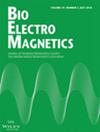Kassra Ghassemkhani, Blake T. Dotta
下载PDF
{"title":"Can Theta Burst Electromagnetic Fields Disrupt Learning in Planaria? Evidence of Impaired Fear-Conditioned Responses","authors":"Kassra Ghassemkhani, Blake T. Dotta","doi":"10.1002/bem.70017","DOIUrl":null,"url":null,"abstract":"<p>This study explored the impact of low-intensity theta burst patterned electromagnetic fields (TBEMF) on fear-related learning in the flatworm species Planaria, a simple model organism known for its regenerative properties and ability to demonstrate basic learning behaviors. Planaria were exposed to an aversive stimulus (light) in a T-maze, and changes in their behavior, including time taken to select an arm and preferred arm selections, were assessed over the course of several days. The TBEMF consisted of five pulsed bursts at 100 Hz with alternating amplitudes and an intensity of 1 μT. In the group exposed to aversive light, a significant decrease in preferred arm selections was observed (<i>p</i> < 0.001), indicating that the planaria successfully learned to avoid the arm associated with the aversive stimulus. However, planaria exposed to TBEMF, either before or after the light exposure phase, did not show the same behavioral adaptation, as their arm selections remained stable, indicating that no fear learning occurred. These findings suggest that TBEMF disrupts the processes involved in fear-related learning, likely by interfering with theta rhythm-dependent mechanisms that are crucial for memory encoding and retrieval. Further exploration of EMF's effects on more complex organisms could reveal additional insights into its broader applications and implications for both basic neuroscience and clinical practice. Bioelectromagnetics. 00:00–00, 2025. © 2025 Bioelectromagnetics Society.</p>","PeriodicalId":8956,"journal":{"name":"Bioelectromagnetics","volume":"46 6","pages":""},"PeriodicalIF":1.2000,"publicationDate":"2025-07-31","publicationTypes":"Journal Article","fieldsOfStudy":null,"isOpenAccess":false,"openAccessPdf":"https://onlinelibrary.wiley.com/doi/epdf/10.1002/bem.70017","citationCount":"0","resultStr":null,"platform":"Semanticscholar","paperid":null,"PeriodicalName":"Bioelectromagnetics","FirstCategoryId":"99","ListUrlMain":"https://onlinelibrary.wiley.com/doi/10.1002/bem.70017","RegionNum":3,"RegionCategory":"生物学","ArticlePicture":[],"TitleCN":null,"AbstractTextCN":null,"PMCID":null,"EPubDate":"","PubModel":"","JCR":"Q3","JCRName":"BIOLOGY","Score":null,"Total":0}
引用次数: 0
引用
批量引用
Abstract
This study explored the impact of low-intensity theta burst patterned electromagnetic fields (TBEMF) on fear-related learning in the flatworm species Planaria, a simple model organism known for its regenerative properties and ability to demonstrate basic learning behaviors. Planaria were exposed to an aversive stimulus (light) in a T-maze, and changes in their behavior, including time taken to select an arm and preferred arm selections, were assessed over the course of several days. The TBEMF consisted of five pulsed bursts at 100 Hz with alternating amplitudes and an intensity of 1 μT. In the group exposed to aversive light, a significant decrease in preferred arm selections was observed (p < 0.001), indicating that the planaria successfully learned to avoid the arm associated with the aversive stimulus. However, planaria exposed to TBEMF, either before or after the light exposure phase, did not show the same behavioral adaptation, as their arm selections remained stable, indicating that no fear learning occurred. These findings suggest that TBEMF disrupts the processes involved in fear-related learning, likely by interfering with theta rhythm-dependent mechanisms that are crucial for memory encoding and retrieval. Further exploration of EMF's effects on more complex organisms could reveal additional insights into its broader applications and implications for both basic neuroscience and clinical practice. Bioelectromagnetics. 00:00–00, 2025. © 2025 Bioelectromagnetics Society.
θ脉冲电磁场会干扰涡虫的学习吗?恐惧条件反应受损的证据
本研究探讨了低强度的θ波脉冲模式电磁场(tbef)对扁虫物种涡虫的恐惧相关学习的影响,涡虫是一种简单的模式生物,以其再生特性和展示基本学习行为的能力而闻名。在t型迷宫中,涡虫暴露在厌恶刺激(光)中,并在几天的过程中评估它们的行为变化,包括选择手臂和首选手臂的时间。tbef由5次100 Hz交变振幅、强度为1 μT的脉冲爆发组成。在暴露于厌恶光线的组中,观察到首选手臂选择显着减少(p < 0.001),这表明涡虫成功地学会了避开与厌恶刺激相关的手臂。然而,无论是在光暴露阶段之前还是之后,暴露于TBEMF的涡虫都没有表现出相同的行为适应,因为它们的手臂选择保持稳定,表明没有发生恐惧学习。这些发现表明,TBEMF可能通过干扰对记忆编码和检索至关重要的θ节奏依赖机制,扰乱了与恐惧相关的学习过程。进一步探索电磁场对更复杂生物体的影响,可以揭示其在基础神经科学和临床实践方面的更广泛应用和影响。生物电磁学。00:00 - 00,2025。©2025生物电磁学学会。
本文章由计算机程序翻译,如有差异,请以英文原文为准。


 求助内容:
求助内容: 应助结果提醒方式:
应助结果提醒方式:


